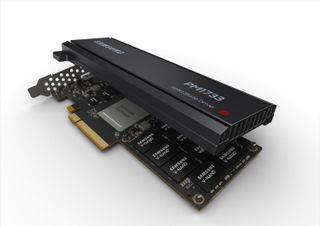Samsung has announced its brand-new PM1733 SSD, which will fully take advantage of the high-speed PCIe 4.0 interface.

Samsung most likely produces the PM1733 with all in-house ingredients. The drive is expected to use the company's proprietary PCIe 4.0 SSD controller, which we don't know the name of yet, and fifth-generation 512Gb TLC (triple-level cell) V-NAND chips. As per Samsung's information, the PM1733 boasts remarkable sequential and random read speeds up to 8 GB/s and 1,500,000 IOPS, respectively. The SSD is backward compatible with the older PCIe 3.0 interface, but it will seriously gimp the drive's exceptional performance.

The Samsung PM1733 will arrive in two form factors. The U.2 variant uses up to four PCIe 4.0 lanes and will be available with capacities up to a whopping 30.72TB. The HHHL (half height, half length) variant, on the other hand, needs up to eight PCIe 4.0 lanes to perform to its full potential. The HHHL model maxes out at 15.36TB. One of the Samsung PM1733 U.2's attributes is the support for the dual-port technology, meaning the drive is accessible by two different systems simultaneously.
Samsung will launch the PM1733 in this quarter. The South Korean tech giant didn't reveal the pricing, but being a SSD of this magnitude and an enterprise-grade product at that, we expect the PM1733 to cost a small fortune.
Stay On the Cutting Edge: Get the Tom's Hardware Newsletter
Join the experts who read Tom's Hardware for the inside track on enthusiast PC tech news — and have for over 25 years. We'll send breaking news and in-depth reviews of CPUs, GPUs, AI, maker hardware and more straight to your inbox.

Zhiye Liu is a Freelance News Writer at Tom’s Hardware US. Although he loves everything that’s hardware, he has a soft spot for CPUs, GPUs, and RAM.
-
bit_user ReplyOne of the Samsung PM1733 U.2's attributes is the support for the dual-port technology, meaning the drive is accessible by two different systems simultaneously.
Hmmm...
First, I thought this might be some confusion with the dual-links involved in SATA-Express.
https://en.wikipedia.org/wiki/SATA_Express#Connectors
But, it seems that dual-port NVMe really does involve bifurcating the x4 link into 2 x2 links, each of which can be connected to a separate controller. This isn't a terribly good explanation, but seems to confirm that dual-port is really a feature aimed at high-availability & fault-tolerance:
https://itpeernetwork.intel.com/an-introduction-to-dual-port-nvme-ssd/#gs.vht9hu
It's a weird feature, because you generally cannot connect a drive to multiple hosts for the simple purpose of data-sharing. I've heard of people doing this decades ago, using SCSI drives, but filesystems and the host I/O subsystems of the day were much simpler.
Most Popular




